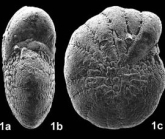Foraminifera taxon details
Fissoelphidium operculiferum Smout, 1955 †
913381 (urn:lsid:marinespecies.org:taxname:913381)
accepted
Species
marine, brackish, fresh, terrestrial
fossil only
Smout, A. H. (1955). Reclassification of the Rotaliidea (Foraminifera) and two new Cretaceous forms resembling Elphidium. <em>Journal of the Washington Academy of Sciences.</em> Vol. 45, No. 7 (July 1955), pp. 201-210., available online at https://www.biodiversitylibrary.org/part/70624#/summary
page(s): p. 209 fig. 1-5 [details]
page(s): p. 209 fig. 1-5 [details]
Hayward, B.W.; Le Coze, F.; Vachard, D.; Gross, O. (2024). World Foraminifera Database. Fissoelphidium operculiferum Smout, 1955 †. Accessed at: https://www.marinespecies.org/foraminifera/aphia.php?p=taxdetails&id=913381 on 2024-07-07
Date
action
by
original description
Smout, A. H. (1955). Reclassification of the Rotaliidea (Foraminifera) and two new Cretaceous forms resembling Elphidium. <em>Journal of the Washington Academy of Sciences.</em> Vol. 45, No. 7 (July 1955), pp. 201-210., available online at https://www.biodiversitylibrary.org/part/70624#/summary
page(s): p. 209 fig. 1-5 [details]
basis of record Ellis, B. F.; Messina, A. (1940-2015). Catalogue of Foraminifera. <em>Micropaleontology Press, American Museum of Natural History, New York.</em> [details]
additional source Consorti, L.; Rashidi, K. (2019). Remarks on Fissoelphidium operculiferum Smout, 1955 (larger Foraminifera, Maastrichtian of Zagros) and comments on the associated rotaloidean and other lamellar perforate Foraminifera. <em>Cretaceous Research.</em> 94: 59-71., available online at https://doi.org/10.1016/j.cretres.2018.10.005 [details] Available for editors [request]
[request]
page(s): p. 209 fig. 1-5 [details]
basis of record Ellis, B. F.; Messina, A. (1940-2015). Catalogue of Foraminifera. <em>Micropaleontology Press, American Museum of Natural History, New York.</em> [details]
additional source Consorti, L.; Rashidi, K. (2019). Remarks on Fissoelphidium operculiferum Smout, 1955 (larger Foraminifera, Maastrichtian of Zagros) and comments on the associated rotaloidean and other lamellar perforate Foraminifera. <em>Cretaceous Research.</em> 94: 59-71., available online at https://doi.org/10.1016/j.cretres.2018.10.005 [details] Available for editors
From editor or global species database
Remark As monospecific genus, we refer to the generic diagnosis of Fissoelphidium. The measurements proposed by Smout (1955) for F. operculiferum from Qatar fit with our observations of specimens in thin section from Iran (Equatorial diameter 2.2 mm–1.3 mm; axial thickness 1 mm–5 mm; Proloculus 80 μm–40 μm; 15 to 12 chambers in the last whorl). There are two and a half whorls of chambers, rarely three. There are 6 chambers in the first whorl and 10 chambers in the second one. Wall thickness is relatively high in the first whorls (around 90 μm), reduced in the last whorl (around 40 μm). The spiral canals diameter variates between 50 μm and 65 μm. The spiral canals branch at the contact with the intraseptal canals. The intraseptal canals diameter is around 17 μm, whereas at the inner contact with the spiral canals may reach more than 25 μm. Smout (1955) defines the enveloping canals as: ‘The radial sutures are incised. On the latest chambers, they are straight, but small alternating branches of them increase in strength on the older parts of the test. Toward the periphery, they render the suture line zigzag, while nearer the poles they form anastomoses and cut the supplementary skeleton into incised granules’ (op. cit. pag 209). This definition suggests the presence of a continuous system of enveloping canals built through the superposition of lamellae. The diameter of the enveloping canals at the chamber suture is around 25–30 μm.We observe the mosaic umbilical ornamentation coming from infolded folia. This produces a kind of wavy pattern clearly observable in oblique or sub-axial sections. The positive parts of this mosaic are called pustules (= incised granules of the umbonal region in Smout, 1955). The meaning of pustules seems not directly related to the protoplasmic stream; however, the grooves were most probably helpful to constrain the protoplasm extrusion. Grooves may be 130–180 μm deep, while their short axis (= distance between pustules) variates between 30 μm up to 100 μm. Alignment of folds formed by folia with those of the previous whorls may appear merged forming a structure resembling to an axial pile, however no true axial piles can be observed. The intraseptal interlocular space occupies the entire septa thickness providing connection between the spiral canals and the ambient environment.
The two sides of the shell are not identical. Whereas one side show clearer and relatively less infolded folia with few pustules, the opposite is intensely pervaded by the mosaic ornamentation. [details]


